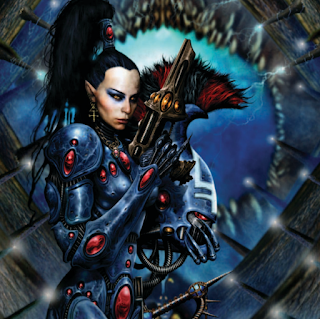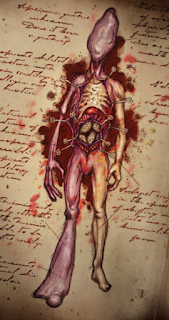 |
| Cubicle 7 |
Warhammer 40,000 Dark Heresy: Creatures Anathema
Published by Cubicle 7
Bestiaries have always been my favorite kind of RPG supplement. But the best ones don’t just endlessly list stat blocks, instead offering interesting, complex enemies and a meaningful context to employ them in. Bestiaries for licensed settings come with further problems. Plenty just settle for statting out iconic foes. Unoriginality aside, it feels like they're withholding the more identifiable parts of a setting to sell off later.
Dark Heresy: Creatures Anathema is thankfully not that kind of bestiary. The 145-page book offers nightmarish adversaries for the players’ Inquisitorial Acolytes to overcome or succumb to. It finds a nice balance between bringing in recognizable tabletop elements, some old favorites, and some entirely new additions. Everything is rooted in the game’s personal corner of the Dark Millennium, the Calixis Sector.
That's partially accomplished through the short diary entries given to each enemy. Every entry is accompanied with the insights of Inquisitor Felroth Gelt, who’s on the classic track of hardliner to radical. He’s about as compelling as he is original. Which is to say, not at all.
The Gelt passages are clumsy and repetitive, failing to define a descent we only catch glimpses of.
Barring a couple of effective pieces, it’s a wasted opportunity in a setting that really benefits from an in-universe, unreliable perspective.Much stronger are the one or two adventure seeds provided with each profile. Most of the book’s adversaries are tailored to a locale in the Calixis Sector, a single planet or even a specific city. The adventure seeds show game masters how they can transplant that enemy to a different area, without changing their rules at all.
Between the background sections, the adventure seeds, profiles, and even the Gelt texts, Creatures Anathema is a bestiary that builds up the atmosphere, history, and personality of the Calixis Sector without making anything too restrictive to actually use in a game.
A Thousand Faces
Creatures Anathema is divided into six categories, each one a major threat to the Inquisition. The shortest chapters are "Mutation" and "Death Worlds," two of the most important parts of Warhammer 40K. I understand the restraints of page counts but it’s strange to see these two so neglected.
Death Worlds in particular benefit from defined rules beyond ‘Yeah, the Acolytes die.” The few entries Creatures Anathema does provide in that section are appropriately weird and hazardous, making its short length a bigger disappointment.
Brief as they are, they at least have some interesting concepts, like a regenerating, flesh stealing mutant crime boss and a potentially sentient killer planet. Some sound advice is given for using these elements in your games, though a section like that accompanies every chapter.
 |
| Cubicle 7 |
The other four sections are more fleshed out and provide some unexpected adversaries. The “Forbidden Science” chapter details the sort of technology that partially caused the Imperium’s archaic approach to knowledge. The daemonic super-computer and body stealing info virus stand out. Three different entries work off the same concept: some form of corrupted servitor. As repetitive as it might seem, I can’t say it bothers me.
The Imperium converting prisoners and dissidents into mindless, cyborg slaves always struck me as one of the more horrific elements of the setting. Especially since vanishingly few in the Imperium see it as anything other than a fact of life.
Creatures Anathema fully exploits that element of quiet, accepted horror, often with a strong sense of irony. Obliviates are feared and hated across the Calixis Sector, decried as a chaotic perversion, a process that destroys one’s soul.
Except their construction is indistinguishable from some patterns of sanctioned servitor.
This is reflected in the actual profile, which is close to a regular servitor but with a special rule that forces Fear checks- raised if the target knew the victim. In this way, Obliviates force Imperial characters to confront the true horror of an atrocity they’ve ignored until now. Even if in-universe most lack the self-awareness to fully grasp that.
Creepy Crawlies
The “Vermin & Predators” section offers some less ethically challenging foes- but that’s not to say it doesn’t get creative. The ultra-survivable Ambull from 40K’s very first edition emerges once more, along with some other horrific foes that won’t be the subject of an entire investigation but could easily disrupt one.
Appropriate to Dark Heresy’s specific themes, even the most monstrous foes tend to come back to humanity in some way. A few of the viler entries in this section, the pulpily named Stenchbeasts of Strank and Fenksworld Pit Thing, are all but said to have once been human, reduced to their current state by pacts with Chaos.
 |
| Cubicle 7 |
Warhammer’s long tradition of “borrowing” continues here as well, with the Skin Taker of Fedrid. Playing to the constant uncertainty and mystery of the Dark Millennium, it’s left unclear what exactly this flaying jungle lurker is. There are a few entries like that but here Creatures Anathema goes as far as providing two different profiles depending on what route the GM settles on. One to represent if it’s a daemon or instead a “Mantid Beast.”
No prizes to guess where they got that idea.
In a remarkable display of restraint and originality, it takes 4 entire chapters for anything with a proper model kit to show up in the pages of Creatures Anathema. With the “Xenos” chapter, some of Warhammer’s less obscure foes emerge but are still outnumbered by stranger additions. Eldar get a decent number of pages dedicated to them, though only a few profiles. Only Dire Avengers, Rangers, and a fickle pirate prince show up and frankly rightfully so. It’s hard to imagine even a well-armed party taking on a faithfully represented Seer or Exarch.
Though Eldar are scarce in the Calixis Sector, both in terms of story and mechanics, Creatures Anathema nudges game masters to wonder why that might be.
Orks and Tyranids split the difference when it comes to the more recognizable Warhammer 40K aliens in this book. Orks are a faction close to my heart, but it is strange to see them in Dark Heresy and especially given this much space. There’s not much intrigue to be had from fungal living weapons modeled off football hooligans.
These profiles are great for a more combat focused Dark Heresy campaign, though admittedly that’s easily one of the weaker parts of the system. Some of the incredibly crowded lists of talents and skills in Creatures Anathema are testament to that.
Even so, it’s one of the better depictions of Orks, as the comedic and more serious elements are given their places. More obnoxious qualities highlighted by the fandom are downplayed or directly contradicted.
The all-consuming Tyranids only get two profiles but much like Eldar there’s a very good, if more obvious reason for that. Lictors are given an appropriately fearsome profile. Creature Anathema’s bad habit of leaning too much into custom talents stacked on top of existing ones is more justified here. The rule allowing Lictor’s to “eat” talents from their victims gives them an unpredictability to what could easily turn into just a big target for a group of well-armed acolytes.
Genestealers also emerge, represented accurately and without having to create multiple new talents for them. Their titular hybrid creating “kiss” rule is vaguely worded, putting them even more in line with their obvious Alien inspirations.
 |
| Cubicle 7 |
The rest of the "Xenos" chapter is dedicated to stranger and frankly more Dark Heresy appropriate creatures. Mind controlling Enslavers, another Rogue Trader throwback, manifest from the warp but some entirely new creations appear as well. The shape shifting Simulacra are by far my favorite, beings that can assume the appearance and memories of those who’s brains they’ve consumed. Their motives are entirely unknown and from personal experience players trying to discover, much less make sense of such a genuinely alien adversary makes for some amazing roleplay.
Man Behind the Curtain
Where the Inquisition goes, Chaos draws near, especially in the Calixis Sector. Creatures Anathema is already saturated in the Dark Gods’ presence long before their dedicated chapter, which provides new daemons to test the Acolytes sanity – and loyalty. Like the “Xenos” section, a few iconic tabletop units make their way in, namely Flesh Hounds, Juggernauts, and Flamers of Tzeentch. The adventure seeds do the heavy lifting, giving players ideas on how to create intrigue around bestial adversaries that are too strong to just throw into a story.
 |
| Cubicle 7 |
The rest are a much stranger bunch, in line with the book’s more creative entries. It shows Creatures Anathema’s team grasped that Chaos is a malevolent, otherworldly force that plays on the fear and passion that created them. The Chaos Gods live up to their title, instead of getting stuck in the gimmicks and stereotypes of the four principal gods.
After the haunted ships and murderous spirits are daemons with a ton of narrative potential, requiring some real thought and planning to use. Assessors of the Black Tontine picks off those who sign a daemonic contract that pays off with each signatories’ death. The Ruination of the Imperfect Beauty lures artists of all stripes to corrupt, exploiting the single flaw in their otherwise perfect work. It’s a horrific bunch that offers a lot more than just a stat block.
Beneath the Skin
The final chapter of Creatures Anathema gives the most direct advice on running Dark Heresy sessions. After giving solid if formulaic formats for using each variety of foe listed in the book, it gives broader advice. It’s all sound and well delivered, noting that playing strictly to the rules and not giving players a chance, much less agency, will lead to a miserable time.
Some fun rules are given, like a random chart to spruce up minor adversaries and more crucially “cinematic” rules to work around how drawn-out combats can get.
 |
| Cubicle 7 |
Art wise, Creatures Anathema is stuffed with recycled pieces. Even at this book’s publication that was hardly a new development in Warhammer and there’s nothing wrong with using what works. A lot of it is taken from the 2003 Sabretooth Games Horus Heresy CCG. The range of freelancers used there led to some very novel takes on the Dark Millennium. Not all of them were good, unfortunately.
Equally inconsistent is the art commissioned for this book. Most of the freelancers brought in captured the atmosphere of the setting as well as the threat posed by the subject. The Clint Langley cover with the Lictor is a particular favorite of mine. That can’t be said for all the commissioned art, some of which doesn’t even fit the descriptions in the text.
Art aside, Creatures Anathema is a strong bestiary and one that displays what made Dark Heresy tick. Like the book itself, you can have an entire campaign using their original adversaries, consigning the identifiable, miniature derived ones to the background, assuming they appear at all. More importantly, you can do that and still capture the feeling of the “Grim Darkness of the Far Future.”
Creatures Anathema, like Dark Heresy itself, touched on the fundamental themes of the setting, offering a surprising and fulfilling experience for fans and newcomers alike.
No comments:
Post a Comment